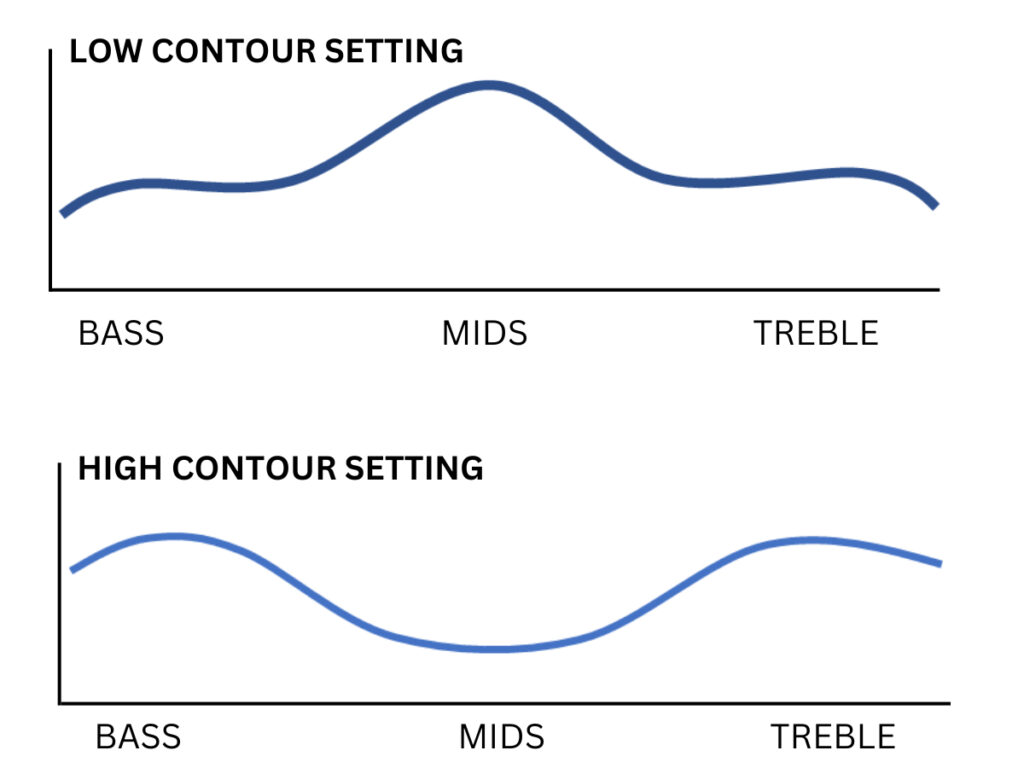Different guitar and bass amplifiers have different controls on them, making it a bit tricky to dial in the amp settings on a new amp you’ve never used before.
One of the most confusing settings I came across on my very first amp (a Marshall MG10) was the “contour” control. In this article I’ll address exactly what this control does and how to use it.
Here’s the quick answer to get us started…
The contour control on an amp adjusts the mid-range frequencies. Increasing the contour will decrease the mid-range frequencies, whereas decreasing the contour will increase the mid-range frequencies. A low contour setting will sound rich whereas a high contour setting will sound hollow.
EQ Basics
Before we jump into the exact role of the contour control, we need to have a good understanding of “EQ”. The EQ (equalisation) is a balance between the bass, mids and treble frequencies:
- Bass frequencies are the low-end frequencies
- Mids are the mid-range frequencies
- Treble frequencies are the high-end frequencies
Having a lot of bass causes the guitar to sound more “boomy” and warm. Having a lot of treble causes the guitar to sound brighter, sharper and more defined. Increasing the mids causes the guitar to sound fuller and richer, whereas decreasing it can cause it to sound thinner, and more open and hollow.
Check out this YouTube video to hear how the bass, mids and treble settings affect the tone of an electric guitar.
Many amplifiers have what’s referred to as a “3-band EQ section” which means that there are independent controls for the bass, mids and treble. However, some have a “2-band EQ” which means there will only be 2 EQ controls (usually bass and treble).
On some amplifiers, you’ll get a 3-band EQ but instead of the controls being bass, mids and treble, they’ll instead be bass, contour and treble. You can even get amps with mids and contour controls.
So what exactly is the contour control?
Contour Control Explained
The contour control controls the mid-range frequencies but in thee opposite control way to a traditional “mids” control. In other words…
- Increasing the contour will decrease the mid-range frequencies
OR
- Decreasing the contour will increase the mid-range frequencies
Having a very high contour setting will “scoop” the mid-range frequencies. This means that the mid-range frequencies are decreased and are lower in relation to the bass and treble frequencies. Conversely, a low contour setting will create a mid-range “hump” and favour them over the bass and treble.

How to Use the Contour Control
When it comes to dialling in the EQ controls, it really is personal preference. Some guitarists like the sound of “scooped” mids (high contour setting) and others prefer the richer sound of boosted mids (low contour setting).
It’s a good idea to play around with your amp settings until you find a tone you like.
When using a new amplifier, I prefer to turn all the EQ settings to mid-way and then adjust the mids/ contour setting first, then the bass, then the treble. Adjusting each control individually makes it easier to dial in the sound I’m looking for.
Low Contour Setting
Having a lower contour setting will boost the mid-range frequencies. This is a popular approach in a wide variety of music styles as it gives the guitar a rich and full sound which can be heard well amongst the other instruments in the band.
However, you may not want a very low contour setting (high mids) if the other instruments in the band are struggling to compete with the guitar. In other words, having the mids very high can make the guitar dominate the mix too much in some situations.
High Contour Setting
Having a high contour setting will cause the mid-range frequencies to be relatively low compared to the bass and treble frequencies. This is not as popular as having a low or balanced contour setting, but it is an approach taken by some heavy metal bands for example, Metallica.
The risk with having the mids very low is that the guitar can get lost in the rest of the band. It may sound good on its own, but in the mix it can sound very weak. In heavy metal this is often counteracted by having high treble, bass, gain and volume.
Some amps have additional controls so make sure you also check out the brand-specific amp controls guide which is relevant to you, to get the most from your rig:
